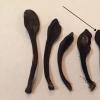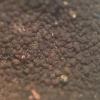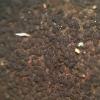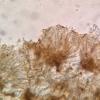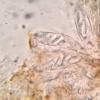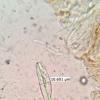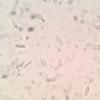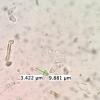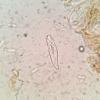
08-12-2025 17:37
 Lothar Krieglsteiner
Lothar Krieglsteiner
20.6.25, on branch of Abies infected and thickened

16-01-2026 00:45
Ethan CrensonHi all, On decorticated hardwood from a New York

10-01-2026 20:00
Tom SchrierHi all,We found picnidia on Protoparmeliopsis mur

13-01-2026 07:28
 Danny Newman
Danny Newman
Chlorociboria glauca on indet. decorticate logThe

15-01-2026 15:55
 Lothar Krieglsteiner
Lothar Krieglsteiner
this one is especially interesting for me because

13-01-2026 08:43
 Danny Newman
Danny Newman
Tricladium varicosporioides on indet. decorticate

07-01-2026 22:22
 Danny Newman
Danny Newman
Tatraea sp. on indet. hardwood The Swag, Great Sm
Parasite on Trichoglossum
Ethan Crenson,
29-07-2021 23:25
Hi all,
This is a parasite I found on fruiting bodies of Trichoglossum farlowii. It was in Beech-Maple-Hemlock woods in the Eastern US. I considered Hypomyces papulasporae, but I don't think it fits very well, especially the microscopic features. Any ideas what this could be?
Growing Nectria-like (?) crowded on the fruiting bodies of Trichoglossum farlowii. Asci are broadly clavate, 40-44 x 8.5-10.5µm. Pores are hyaline, fusiform with one end narrower than the other (like the sole of a shoe) 8.5-10.5 x 3-3.8µm.
From what I have read the Hypomyces papulasporae teleomorph has much longer cylindrical asci and larger ascospores.
Thanks very much in advance,
Ethan
Hans-Otto Baral,
30-07-2021 09:03

Re : Parasite on Trichoglossum
Woww! This looks like Gelatinopsis geoglossi! It is in my paper on that genus. I know this only from the dead type material, so vital characters are now available.
Do you have the free ascus without these ugly bars?
There is no sequence to me knowledge, which is especially important because it is the type of Gelatinopsis.
Do you know an institute to do that?
Ethan Crenson,
30-07-2021 13:32
Re : Parasite on Trichoglossum
Here is the free ascus without ugly bars. I am very excited to know this is Gelatinopsis geoglossi. I will see if it is possible to sequence it here. I suppose it would be best to culture it first? I am not very well versed in the technical aspects of fungal sequencing!
Hans-Otto Baral,
30-07-2021 15:58

Re : Parasite on Trichoglossum
Thanks! Sorry when I am direct, but I really do not like these pixis hiding important features, much better is to put a scale on a photo.
Culturing could be a problem because parasites often do not germinate. The apos are minute indeed, but abundant. You can either organize a tube for the apos and detach them yourself, our give instructions to the lab how the fungus looks. It could be that special primers would select the parasite. Maybe Luis Quijada is interested, because it touches a little his work on Tympanidaceae. My guess is Helicogoniaceae. There exist three sequences of Gelatinopsis, G. fungicola, G. exidiophila and G. hysteropatellae, in GenBank, together with some associated genera. I will ask him if he wants it.
Here is a link to images:
Zotto
Ethan Crenson,
31-07-2021 17:22
Re : Parasite on Trichoglossum
On the contrary! I appreciate your directness.
I will either ask my friend in Brooklyn to help with sequencing, or contact Luis. But I imagine that the parasite being in such proximity to another fungus must make it more difficult to get an uncontaminated sequence. I did notice a few stray Trichoglossum spores when I did the microscopy. Is this also why special primers could be useful?
Again thanks!
Ethan
Hans-Otto Baral,
31-07-2021 20:23

Re : Parasite on Trichoglossum
Yes, it would be a possibility if the normal primers yield the wrong fungus.
I also see the setae among the apothecia which might break and contaminate.


